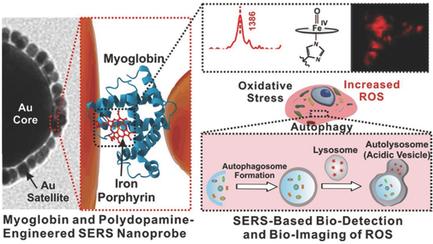Our official English website, www.x-mol.net, welcomes your
feedback! (Note: you will need to create a separate account there.)
Myoglobin and Polydopamine‐Engineered Raman Nanoprobes for Detecting, Imaging, and Monitoring Reactive Oxygen Species in Biological Samples and Living Cells
Small ( IF 13.0 ) Pub Date : 2017-09-13 , DOI: 10.1002/smll.201701584 Sumit Kumar 1 , Amit Kumar 1 , Gyeong-Hwan Kim 1 , Won-Kyu Rhim 1 , Kevin L. Hartman 1 , Jwa-Min Nam 1
Small ( IF 13.0 ) Pub Date : 2017-09-13 , DOI: 10.1002/smll.201701584 Sumit Kumar 1 , Amit Kumar 1 , Gyeong-Hwan Kim 1 , Won-Kyu Rhim 1 , Kevin L. Hartman 1 , Jwa-Min Nam 1
Affiliation

|
Highly reliable detection, imaging, and monitoring of reactive oxygen species (ROS) are critical for understanding and studying the biological roles and pathogenesis of ROS. This study describes the design and synthesis of myoglobin and polydopamine‐engineered surface‐enhanced Raman scattering (MP‐SERS) nanoprobes with strong, tunable SERS signals that allow for specifically detecting and imaging ROS sensitively and quantitatively. The study shows that a polydopamine nanolayer can facilitate the modification of Raman‐active myoglobins and satellite Au nanoparticles (s‐AuNPs) to a plasmonic core AuNP (c‐AuNP) in a controllable manner and the generation of plasmonically coupled hot spots between a c‐AuNP and s‐AuNPs that can induce strong SERS signals. The six‐coordinated Fe(III)‐OH2 of myoglobins in plasmonic hotspots is reacted with ROS (H2O2, •OH, and O2−) to form Fe(IV)O. The characteristic Raman peaks of Fe(IV)O from the Fe‐porphyrin is used to analyze and quantify ROS. This chemistry allows for these probes to detect ROS in solution and image ROS in cells in a highly designable, specific, and sensitive manner. This work shows that these MP‐SERS probes allow for detecting and imaging ROS to differentiate cancerous cells from noncancerous cells. Importantly, for the first time, SERS‐based monitoring of the autophagy process in living cells under starvation conditions is validated.
中文翻译:

肌红蛋白和聚多巴胺设计的拉曼纳米探针,用于检测,成像和监测生物样品和活细胞中的活性氧
活性氧(ROS)的高度可靠的检测,成像和监控对于理解和研究ROS的生物学作用和发病机理至关重要。这项研究描述了肌红蛋白和聚多巴胺工程化的表面增强拉曼散射(MP-SERS)纳米探针的设计与合成,这些探针具有可调节的强SERS信号,可以特异性地灵敏和定量检测ROS。研究表明,聚多巴胺纳米层可以以可控的方式促进拉曼活性肌球蛋白和卫星金纳米颗粒(s-AuNPs)转变为等离激元核心AuNP(c-AuNP),并在ac-之间形成等离激元耦合的热点。可以诱导强SERS信号的AuNP和s-AuNP。六配位的Fe(III)-OH 2在等离子体激元热点肌红蛋白与ROS(H反应2 ö 2,•OH,和O 2 - ),形成的Fe(IV)O。铁卟啉中Fe(IV)O的特征拉曼峰用于分析和定量ROS。这种化学性质允许这些探针以高度可设计的,特异性的和敏感的方式检测溶液中的ROS并在细胞中对ROS进行成像。这项工作表明,这些MP‐SERS探针可以检测和成像ROS,以区分癌细胞和非癌细胞。重要的是,首次验证了在饥饿条件下基于SERS的活细胞自噬过程监测。
更新日期:2017-09-13
中文翻译:

肌红蛋白和聚多巴胺设计的拉曼纳米探针,用于检测,成像和监测生物样品和活细胞中的活性氧
活性氧(ROS)的高度可靠的检测,成像和监控对于理解和研究ROS的生物学作用和发病机理至关重要。这项研究描述了肌红蛋白和聚多巴胺工程化的表面增强拉曼散射(MP-SERS)纳米探针的设计与合成,这些探针具有可调节的强SERS信号,可以特异性地灵敏和定量检测ROS。研究表明,聚多巴胺纳米层可以以可控的方式促进拉曼活性肌球蛋白和卫星金纳米颗粒(s-AuNPs)转变为等离激元核心AuNP(c-AuNP),并在ac-之间形成等离激元耦合的热点。可以诱导强SERS信号的AuNP和s-AuNP。六配位的Fe(III)-OH 2在等离子体激元热点肌红蛋白与ROS(H反应2 ö 2,•OH,和O 2 - ),形成的Fe(IV)O。铁卟啉中Fe(IV)O的特征拉曼峰用于分析和定量ROS。这种化学性质允许这些探针以高度可设计的,特异性的和敏感的方式检测溶液中的ROS并在细胞中对ROS进行成像。这项工作表明,这些MP‐SERS探针可以检测和成像ROS,以区分癌细胞和非癌细胞。重要的是,首次验证了在饥饿条件下基于SERS的活细胞自噬过程监测。











































 京公网安备 11010802027423号
京公网安备 11010802027423号